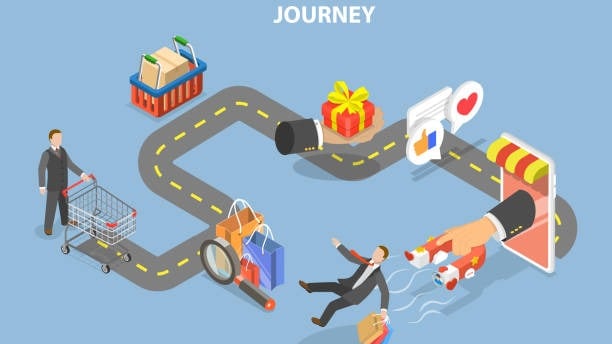Your blog post
Blog post description.


How Journey Mapping Can Transform Your Small Business Today
Let's start with a hypothetical business owner named Sarah. Sarah owns a boutique fitness studio. Despite passionate instructors and great equipment, she's watching potential clients slip away. They visit her website, maybe even call, but somehow never make it through the door. Sound familiar?
This isn't just a marketing problem—it's a journey problem. And it's exactly what customer journey mapping can solve.
What Is Journey Mapping, Really?
Think of journey mapping as creating a step-by-step movie of your customer's experience, from the moment they first hear about you until they become loyal advocates. It's not about fancy diagrams or corporate buzzwords. It's about understanding the real, messy, human experience of doing business with you.
For small businesses, this matters more than ever. You don't have the luxury of losing customers to confusion, frustration, or friction. Every interaction counts.
The Hidden Costs of Broken Journeys
Most small business owners focus on getting customers in the door, but overlook what happens next. Consider these common journey breakdowns:
The Website Black Hole: A potential customer finds your website but can't figure out what you do or how to get started. They leave within 30 seconds, never to return.
The Phone Tag Nightmare: Someone calls with interest, gets voicemail, leaves a message, and waits. Three days later, they've already found your competitor.
The Onboarding Confusion: A new customer signs up but doesn't know what to expect next. They feel lost, question their decision, and may not stick around long enough to see real value.
Each of these represents lost revenue that journey mapping can recover.
Real-World Journey Mapping in Action
Let's return to Sarah's fitness studio. After mapping her customer journey, she discovered three critical friction points:
Discovery Stage: Her website showed class schedules but didn't explain what each class was actually like. First-time visitors felt intimidated and overwhelmed.
Consideration Stage: Interested prospects had to call during business hours to learn about pricing or book a trial class. Working professionals couldn't reach her.
First Visit: New members arrived not knowing where to park, what to bring, or what to expect. Many felt awkward and never returned.
The solutions were surprisingly simple. Sarah added video previews of each class type, implemented online booking with clear pricing, and created a "first visit" email sequence that arrived the day before someone's trial class.
Result? A 35% increase in trial-to-membership conversions within two months.
Your Journey Mapping Toolkit
You don't need expensive software or consultants to start mapping your customer journey. Here's how to begin:
Step 1: Walk in Your Customer's Shoes. Start with a simple question: "How does someone go from never hearing about my business to becoming a happy customer?" Write down every single step, no matter how small.
Step 2: Identify the Emotion at Each Stage. For each step, ask: "How does my customer feel here?" Excited? Confused? Frustrated? Confident? These emotions are where your biggest opportunities hide.
Step 3: Find the Friction Point. Look for places where customers might get stuck, confused, or give up. These could be unclear website navigation, long response times, complicated processes, or missing information.
Step 4: Test Your Assumptions. Ask real customers about their experience. You might be surprised by what they tell you. That "simple" process you're proud of might be their biggest source of confusion.
Quick Wins from Journey Mapping
The beauty of journey mapping for small businesses is that small changes often yield big results:
Communication Gaps: Maybe you're great at what you do but terrible at explaining it. Journey mapping reveals exactly where clearer communication can eliminate confusion.
Timing Issues: Perhaps your follow-up emails arrive too late, or your onboarding happens too fast. Mapping helps you find the perfect rhythm.
Missing Steps: You might discover that customers need reassurance or information at stages you never considered.
Technology Friction: Simple fixes like online scheduling, automatic confirmations, or mobile-friendly forms can dramatically improve the experience.
Making It Sustainable
Journey mapping isn't a one-time exercise. Customer expectations evolve, your business grows, and new friction points emerge. The most successful small businesses make journey optimization an ongoing practice.
Start small. Pick one part of your customer experience that feels problematic and map just that section. Maybe it's your onboarding process or your sales consultation. Fix what you find, measure the results, then move to the next section.
The Competitive Advantage
Here's the secret: most of your competitors aren't thinking about customer journeys at all. They're focused on their products, their services, and their processes. They're not asking the crucial question: "What's it like to be our customer?"
That's your opportunity. By mapping and optimizing your customer journey, you're not just improving individual touchpoints—you're creating an entirely different kind of business. One that feels effortless, intuitive, and genuinely helpful.
In a world where customers have endless choices, the businesses that win are the ones that make choosing easy. Journey mapping is how you get there.
Ready to see your business through your customer's eyes? Start with one simple question: "What's the very first thing someone experiences when they discover my business?" Then follow that thread wherever it leads.
The answers might surprise you—and transform your bottom line.
